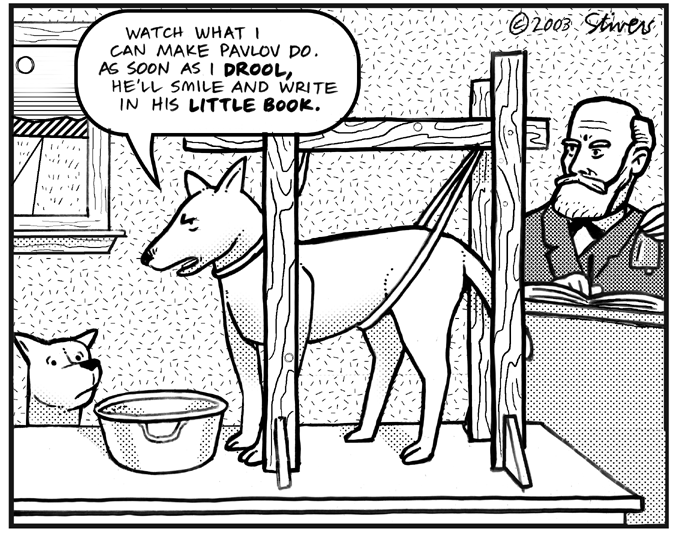Lessons from CBT: Classical conditioning and the confusion of human behaviour
- Self-Care Library

- May 18, 2020
- 7 min read
Updated: May 31, 2020
Have you ever tried to change a behaviour and immediately fallen back on old habits, or procrastinated on goals that were important to you? When contemplating the human mind, we often like to focus on its depths and intricacies - after all, we are the most psychologically developed creature in known existence. However, in the study of human behaviour, it is important to remember that at the end of the day, we're all animals too. So why do some of our behaviours make so little sense? A lot of wisdom can actually be found from revisiting one of science's most famous animal friends: Pavlov's dog.

Pavlovian Conditioning
In 1902, Russian scientist Ivan Pavlov made a discovery that would go on to revolutionise the study of human behaviour. What is surprising about this, is that Pavlov was not a psychologist - he was a physiologist with an interest in digestion. Even more surprising is the subject of his 1902 investigation: dog drool.
As the story goes, every time Pavlov fed his experimental dogs, he would ring a bell (in actuality it was a buzzer, however a bell is commonly used in this story due to a mistranslation of the Russian word for buzzer). The dogs would salivate when their food arrived. After a certain amount of time, Pavlov noticed that his dogs had begun to associate the bell sound with food - they started to salivate whenever the bell was played, regardless of whether it was accompanied by a meal. This kind of behaviour shaping, where repeated pairing of a conditioned stimulus (bell) and an unconditioned stimulus (food) can lead to automatic responses in subjects (conditioned response), is known as Pavlovian Conditioning. (Note: For simplicity, this article will combine elements of Pavlovian and Operant conditioning and refer to them both as "conditioning").

Cartoon by Mark Stivers, stiverscartoons.com
If dogs can be trained to salivate on command, what about humans? Even though human behaviour is incredibly complicated, Pavlovian conditioning is just as effective on us as any other animal - for example, the Pavlovian bell-and-saliva conditioning has been replicated in both humans and cockroaches. Humans can be conditioned to perform a vast range of behaviours - one particularly unethical experiment from the 1920s even managed to successfully condition a human toddler to be terrified of fluffy animals, by pairing all exposure to them with a loud and scary gong-sound. This conditioning is constantly occurring without us even realising it, and can contribute to some of our most mystifying behaviours, such as procrastination, superstition, and gambling.
Types of Conditioning
Within conditioning, we focus on the pairing of two stimuli to achieve a response. These pairings can then be used to either encourage or discourage a behaviour. Encouraging conditioning is known as "reinforcement" - for example, if a dog associates a bell with something desirable, such as food, then this bell can be used to "reinforce" desirable behaviours, such as sitting. Discouraging conditioning is known as "punishment" (no surprises there) - for example, if a fluffy animal is associated with a scary gong, then exposure to fluffy animals can be used to "punish" and therefore reduce the frequency of undesirable behaviours.
This can then be broken down further to two different kinds of punishment and reinforcement: positive punishment/reinforcement, where the desired/undesired behaviour is achieved by "adding" something, and negative punishment, where the desired/undesired behaviour is achieved by "subtracting" something. In this case, positive and negative don't take on their commonly accepted definitions of positive = desirable and negative = undesirable, but rather their more mathematical definitions of positive = addition and negative = subtraction. Let's break this down.
Positive Punishment involves pairing an undesirable behaviour with an additional undesirable experience. For example, to discourage a dog from jumping up, an example of positive punishment (that we don't recommend) would be to hit the dog. The dog then pairs jumping up with the addition of pain (again, please don't hit your dogs). In comparison, Negative Punishment involves pairing an undesirable behaviour with the removal of something desirable. For example, if a teenager misbehaved and their parents banned them from watching TV for a week, that would be negative punishment - a desirable experience was removed.
Positive Reinforcement operates on the opposite principle - the addition of desirable experiences, and the removal of undesirable experiences. For example, giving a child a lolly every time they behave well would be positive reinforcement. Alternatively, removing chores when a child behaves well would be negative reinforcement.
Accidental Conditioning
Earlier in this article, we mentioned that conditioning can happen without us even realising that it is taking place. Some examples of this may be fairly obvious - receiving money for work is a clear example of positive reinforcement, for example. However, the most subtle form of conditioning that influences our daily lives can be a lot harder to see in action - this usually stems from negative reinforcement.
To recap, negative reinforcement is when a behaviour is encouraged by the removal of something undesirable. What we don't often realise is that this occurs all the time, through how we avoid unpleasant emotions (i.e. remove an undesirable stimulus). Through this pattern, humans can be conditioned by their bodies into all sorts of unhealthy behaviours.
Procrastination, or postponing productive action on a task, is a really good example of negative reinforcement in action. We often procrastinate on goals that we find stressful - a high-stakes project at work for example. Often, the more concerned or scared we are of being unsuccessful in our task, the more likely we are to procrastinate. From a rational perspective, this appears counter-intuitive - surely if we are scared of failure, we should be more motivated to avoid it? The culprit here is negative reinforcement.
Every time we think about a high stakes goal, we undergo feelings of stress. From a conditioning perspective, this stress is an undesirable experience. Therefore, any behaviour that we can perform to alleviate this undesirable experience, no matter how temporary, will become reinforced - just like Pavlov's dog associated the bell and the food, our brains will physiologically begin to associate this behaviour with the reward of removing stress. Unfortunately for us, when stress is caused by thinking about a high-stakes project, one of the easiest things that our body can do to remove that stress is to simply avoid those thoughts - hence, procrastination.
What's worse is that, the more you avoid thinking about a project, the closer the deadline comes (and the more stressful those thoughts become). As a result, our bodies become increasingly motivated to avoid those stressful thoughts, and the reward (stress reduction) becomes more and more engrained in our bodies. This is called a negative reinforcement cycle, where avoidance of stress = increased stress = increased avoidance. Negative reinforcement cycles are why, in our most anxious states, we will procrastinate at just about anything - and even put aside behaviours that we would otherwise enjoy.
Understanding conditioning can help us understand how to prevent procrastination. From the perspective of conditioning, there are two approaches. The first is to pair the desired productive behaviour with a form of positive reinforcement that is stronger than the relief of stress that's associated with not performing the desired productive behaviour. The effectiveness of this depends on how desirable the positive reinforcer is, and the extent of the stress that is associated with the task. Allowing yourself to go for a walk as a reward for certain amounts of time spent studying will be successful or unsuccessful depending on how much you like walking, for example. It's also important to think carefully about what you use as a positive reinforcer - for example, it is really common for people to want to use unhealthy food as a positive reinforcer. This runs the risk of conditioning yourself to use unhealthy food to avoid negative emotions instead of procrastinating, which can be undesirable for our physical health. The same applies to smoking, drinking, etc.
The second conditioning-based approach to procrastination would be to try and reduce the stress caused by the desired behaviour, and therefore nullify the reinforcement that comes about from ceasing the desired behaviour. Examples might be to play relaxing music, or to complete the task with friends, or to break the behaviour down into smaller parts so that it feels less overwhelming.
When Conditioning Gets Clinical
Other than procrastination, conditioning is often the psychological route of several more severe disorders. For example, negative reinforcement can enhance most phobias, where avoidance of the phobic object (such as a spider) is increasingly reinforced by a reduction in anxiety, eventually leading to a state where the avoidant behaviour is deeply engrained. Conditioning is also the behavioural stem for a lot of addictions, where negative emotions may be eased by an alternate behaviour - such as drinking, gambling, engaging sexual intercourse, etc. Addictions are further complicated by the fact that they involve positive reinforcement and occasionally positive punishment as well (e.g. stressful thoughts = consumption of a drug = negative reinforcement from reduction in stressful thoughts + positive reinforcement from introduction of mental high state; and in some cases, abstinence from drug = positive punishment from withdrawal symptoms).
While can be useful to understand these disorders through the lens of conditioning, for these more serious behaviours we will always recommend seeking support from a medical professional.
Our final note:
Humans are very complex creatures. We have built a more evolutionarily successful society than any other animal in known existence. Even so, the mechanisms involved with some of our behaviours can actually be quite simple to understand, and are also present in most other animals. We'd like to challenge you to start thinking about how conditioning impacts your own behaviour - it can be a lot more present than anyone ever realised.
References:
Clark, R. (2004). The classical origins of Pavlov's conditioning. Integrative Physiological & Behavioural Science, 39(1), 279 - 294. Doi: 10.1007/BF02734167
Davey, G. (1992). Classical conditioning and the acquisition of human fears and phobias: A review and synthesis of the literature. Advances in Behaviour Research and Therapy, 14(1), 29 - 66. Doi: 10.1016/0146-6402(92)90010-L
Digdon, N., Powerll, R., & Harris, B. (2014). Little Albert's alleged neurological impairment: Watson, Rayner, and historical revision. History of Psychology, 17(4), 312 - 324.
Ferrari, J., Johnson, J., & McCown, W. (1995). Procrastination Research. In: Procrastination and Task Avoidance. The Springer Series in Social Clinical Psychology. Springer, Boston, MA
Holland R, & Matthews B. (1970). Conditioned reflex salivary secretion in man. Archives of Oral Biology,15(1), 761–767
McConnell, J. (2009). Negative reinforcement and positive punishment. Teaching of Psychology, 17(4), 247 - 249. Doi: 10.1207/s15328023top1704_10
Watanabe, H., & Mizunami, M. (2007). Pavlov's cockroach: Classical conditioning of salivation in an insect. PloS one,2(6), e529. Doi: 10.1371/journal.pone.0000529
Wright, F., Beck, A., Newman, C., & Liese, B. (1993). Cognitive therapy of substance abuse: Theoretical rationale. NIDA research monograph, 137(1), 123 - 46.



Comments